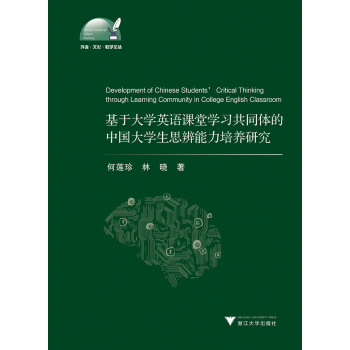![牛津社会语言学丛书·交际界位研究:社会语言学视角 [Stance Sociolinguistic Perspectives]](https://pic.windowsfront.com/12294417/5aa797f2Nc0fb7833.jpg)

具体描述
内容简介
社会语言学是研究语言与社会多方面关系的学科,它从社会科学的不同角度,诸如社会学、人类学、民族学、心理学、地理学和历史学等去考察语言。自20世纪60年代发端以来,社会语言学已经逐渐发展成为语言学研究中的一门重要学科,引发众多学者的关注和探究。“牛津社会语言学丛书”由国际社会语言学研究的两位领军人物——英国卡迪夫大学语言与交际研究中心的教授Nicolas Coupland和Adam Jaworski(现在中国香港大学英语学院任教)——担任主编。丛书自2004年由牛津大学出版社陆续出版以来,推出了一系列社会语言学研究的专著,可以说是汇集了这一学科研究的新成果,代表了当今国际社会语言学研究的高水平。
我们从中精选出九种,引进出版。所选的这些专著内容广泛,又较贴近我国学者研究的需求,涵盖了当今社会语言学的许多重要课题,如语言变体与语言变化、语言权力与文化认同、语言多元化与语言边缘化、语言与族裔、语言与立场(界位)、语言与新媒体、语用学与礼貌、语言与法律以及社会语言学视角下的话语研究等等。其中既有理论研究,又有方法创新;既有框架分析建构,又有实地考察报告;既体现本学科的前沿和纵深,又展现跨学科的交叉和互补。
相信《牛津社会语言学丛书·交际界位研究:社会语言学视角》的引进出版能为从事社会语言学研究的读者带来新的启示,进一步推动我国语言学研究的发展。
目录
Contributors1 Introduction: The Sociolinguistics of Stance
2 Stance, Style, and the Linguistic Individual
3 Stancein a Colonial Encounter: How Mr Taylor Lost His Footing
4 Stance and Distance: Social Boundaries, Self-LaminaLion, and Metalinguistic Anxiety in White Kenyan Narratives about the African Occult
5 Morallrony and Moral Personhood in Sakapultek Discourse and Culture
6 Stance in a Corsican School: Institutional and Ideological Orders and the Production of Bilingual Subjects
7 From Stance to Style: Gender, Interaction, and Indexicality in Mexican Immigrant Youth Slang
8 Style as Stance: Stance as the Explanation for PatteFns of Sociolinguistic Variation
9 Taking an Elitist Stance: Ideology and the Discursive Production of Social Distinction
10 Attributing Stance in Discourses of Body Shape and Weight Loss
Index
精彩书摘
《牛津社会语言学丛书·交际界位研究:社会语言学视角》:his volume is a sociolinguistic exploration of one of the fundamental properties of communication: stancetaking. Stancetaking-taking up a position with Fespect to the form or the content of one's utterance-is central because speaker positionality is built into the act of communication. Although.some forms of speech and writing are more stance-saturated than others, there is no such thing as a completely neutral position vis-et-yis one's lin8uistic productions, because neutrality is itself a stance. To take a simple example, when we choose a verb of saying to introduce speech rep- resented as another's, our choices entail stances toward that speech, from neutrality ("said") to doubt ("alleged"); every choice js defined in contrast to other semantic options..By the same token, speech cannot be affectively neutral; we can indeed convey a stance of affective neutrality, but it will of necessity be read in relation to other possible emotional orientations we could have displayed.
Epistemic and affective stances are both socially situated and socially consequential, as will be explored below. Speech is always produced and interpreted within a sociolinguistic matrix: that is, speakers make sociolinguistically inflected choices and display orientations to the sociolinguistic meanings associated with forms of speech. Thus sociolinguistics has much to offer to the study of stancetaking.
The study of stance in the contemporary literature is wide-ranging and quite heterogeneous (see Englebretson 2007), and has a robust history in a number of analytic traditions, ranging from corpus-linguistic treatments of authorial stance as connected to particular academic genres, to critical discourse analyses of embedded stances in political, cultural, and persuasive texts, to studies of stancecaking as an interactional and discursive phenomenon, to the analysis of stance-saturated linguistic forms as they are used to reproduce (or chaltenge) social, political, and moral hierarchies in different cultural contexts. The aim of this volume is to map out the sociolinguistics of stance, bringing together analyses that allow us to explore both what the study of stance has to offer sociolinguistic theory, and to define the territory occupied by sociolinguistic approaches to stance as it overlaps with and is distinct from the territory occLrpied by other approaches. This introduction is therefore not intended to be an encyclopedic overview of' research on stance in all of the research traditions in which it has been used; nor is it intended to be an exhaustive review of research on stance in sociolinguistics and linguistic anthropology. The goal is at once more modest and more focused: to identify dimensions of stance research that are particularly salient for sociolinguistics, and to situate the sociolinguistic focus on stance in relation to related concepts and currents ot analysis within sociolinguistics and linguistic anthropology. With respect to these existing analytical traditions, I will argue that the concept of stance is a uniquely productive way of conceptualizing the processes of indexicalization that are the link between individual performance and social meaning.
Taken as a whole, the lines of research discussed below are concemed with positionality: how speakers and writers are necessarily engaged in positioning themselves vis-a-vis their words and texts (which are embedded in tustories oflinguistic and textual production), their imerlocutors and audiences (both actual and virtual/projected/ imagined), and with respect to a context that they simultaneously respond to and con-struct linguistically. One of the primary goals of a sociolinguistic approach to stance is to explore how the taking up of particular kinds of stances is habitually and convention- ally associated with particular subject positions (social roles and identities; notions of personhood), and interpersonal and social relationstups Oncluding relations of power) more broadly. Secondly, a sociolinguistics of stance has a crucial role to play in theorizing the relationship between acts of stance'and the sociocultural field: in particular the role these acts play in social (and sociolinguistic) reproduction and change.
As an emergent property of interaction, stance is not transparent in either the linguistic or the sociolinguistic, but must be inferred from the empirical study of interactions in social and historical context. A particular linguistic stance (or a set of stances taken over time) may index multiple selves and social identrties; conversely, it may index a single social identity, a personal identity that endures over time (referred to in Johnstone, this volume, as an ethos of self) or a privileged, "core" self (McIntosh, this volume). Speaker stances are thus performances through which speakers may align or disalign themselves with and/or ironize stereotypical associations with particular linguistic forms; stances may thus express multiple or ambiguous meanings. This makes stance a crucial point of entry in analyses that focus on the complex ways in which speakers manage multiple identities (or multiple aspects of identity). The focus on process also foregrounds multiplicities in the audiences indexed by particular linguistic practices, and on the social dynamics and consequences of audience reception, uptake, and interpretation.
……
前言/序言
社会语言学是研究语言与社会多方面关系的学科,它从社会科学的不同角度,诸如社会学、人类学、民族学、心理学、地理学和历史学等去考察语言。自20世纪60年代发端以来,社会语言学已经逐渐发展成为语言学研究中的一门重要学科,引发众多学者的关注和探究。“牛津社会语言学丛书”由国际社会语言学研究的两位领军人物——英国卡迪夫大学语言与交际研究中心的教授Nicolas Coupland和Adam Jaworski(现在中国香港大学英语学院任教)——担任主编。丛书自2004年由牛津大学出版社陆续出版以来,推出了一系列社会语言学研究的专著,可以说是汇集了这一学科研究的最新成果,代表了当今国际社会语言学研究的最高水平。
我们从中精选出九种,引进出版。所选的这些专著内容广泛,又较贴近我国学者研究的需求,涵盖了当今社会语言学的许多重要课题,如语言变体与语言变化、语言权力与文化认同、语言多元化与语言边缘化、语言与族裔、语言与立场(界位)、语言与新媒体、语用学与礼貌、语言与法律以及社会语言学视角下的话语研究等等。其中既有理论研究,又有方法创新;既有框架分析建构,又有实地考察报告;既体现本学科的前沿和纵深,又展现跨学科的交叉和互补。
相信丛书的引进出版能为从事社会语言学研究的读者带来新的启示,进一步推动我国语言学研究的发展。
用户评价
这本书给我带来的最直接感受是其跨学科的广阔视野。作者似乎游刃有余地穿梭于社会学、人类学、心理学和语言学等多个领域之间,将不同学科的精妙工具熔于一炉,来解析语言现象。这种融汇贯通的视野,使得最终的分析结论具有了无与伦比的丰富性和解释力。它没有固守单一的理论阵地,而是以开放的心态接纳多元视角,这正是当代前沿研究的标志。读完后,你会发现自己对许多过去模糊的概念都有了更清晰、更立体的认知,仿佛是站在一个制高点上俯瞰整个知识版图。它鼓励读者跳出舒适区,用更包容和整合的思维去面对复杂的现实问题。对于渴望拓宽知识边界,寻求真正跨学科洞察的求知者来说,这本书的价值无可估量。
评分从装帧设计和排版来看,这本书也体现了出版方对学术品质的尊重与追求。纸张的质感、字体的选择,都营造出一种沉静而专注的阅读氛围,让人愿意沉下心来,细细品味其中的智慧。更重要的是,书中对各种术语的界定和引文的标注都做得极为规范和详尽,这对于希望深入研究的读者来说,提供了极大的便利。它不仅仅是一本可供阅读的书,更是一本可以随时查阅和引用的工具书。这种对细节的极致关注,体现了作者和编辑团队对学术诚信的承诺。阅读体验的舒适度,直接影响了知识吸收的效率,而这本书在这方面做得非常出色,让漫长的阅读旅程变得轻松愉悦,毫不费力。
评分这部作品的震撼之处,在于它对“语境”和“互动”的深刻剖析。作者仿佛是一位高明的舞台导演,精确地捕捉了语言在真实社会场景中上演的每一出“戏”。书中的论述,总是能让人立刻联想到生活中的无数个场景,那种“原来如此”的顿悟感贯穿始终。它打破了我们过去对语言的刻板印象,揭示了话语背后的权力结构、身份构建和社会契约。阅读的过程,与其说是学习理论,不如说是一次自我审视的过程。我们不禁会反思自己是如何在不同的情境下调整自己的“声音”和“姿态”的。这种强烈的代入感和反思性,是许多纯理论著作难以企及的高度。它不仅仅是学术的,更是关乎我们如何作为社会成员存在于世的哲学拷问。
评分这本书的语言风格和叙述方式,简直让人欲罢不能。作者的笔触细腻而富有洞察力,总能在看似平淡的叙述中,挖掘出人性的深度和社会的复杂性。读起来,就像是跟一位智者在探讨那些我们日常生活中习以为常,却从未深究过的话题。每一个段落都充满了思辨的火花,让人忍不住停下来,反复咀嚼其中的含义。那种感觉,不是简单的信息获取,更像是一场思维的洗礼,拓宽了理解世界的边界。尤其在处理那些微妙的社会互动和人际关系时,作者展现出的那种敏锐的捕捉能力,让人拍案叫绝。读完之后,合上书本,心中久久不能平静,仿佛打开了一扇新的大门,看待周围的世界都变得不一样了。我非常欣赏作者在保持学术严谨性的同时,又能将复杂的概念阐释得如此生动形象,让即便是初涉该领域的读者也能轻松领会其中的精髓。
评分这本书的结构安排堪称教科书级别的范本,逻辑链条清晰到令人惊叹。从宏观的理论框架构建,到微观的案例分析深入,每一步都走得稳健而有力。我尤其欣赏作者如何巧妙地将看似散落的知识点串联起来,形成一个完整且具有内在张力的知识体系。每一次阅读的推进,都像是攀登一座精心规划的山峰,视野随着高度的提升而不断开阔。作者在论证过程中展现出的那种严密的推理能力,让人不得不信服。而且,书中穿插的那些引人深思的案例,绝不仅仅是简单的佐证,它们本身就充满了故事性,极大地丰富了阅读体验。这本书的价值在于,它不仅告诉你“是什么”,更告诉你“为什么”以及“如何理解”。对于那些追求系统化知识建构的读者来说,这本书无疑是宝贵的财富,它提供了一个坚实的基石。
相关图书
本站所有内容均为互联网搜索引擎提供的公开搜索信息,本站不存储任何数据与内容,任何内容与数据均与本站无关,如有需要请联系相关搜索引擎包括但不限于百度,google,bing,sogou 等,本站所有链接都为正版商品购买链接。
© 2025 windowsfront.com All Rights Reserved. 静流书站 版权所有
















![中国高技术产业统计年鉴(2017 附光盘) [China Statistics Yearbook on High Technology Industry] pdf epub mobi 电子书 下载](https://pic.windowsfront.com/12297676/5a717fecN8baf2e9b.jpg)



![喜马拉雅藏族社会家庭与婚姻研究(田野调查) [Himalayan Tibetan society, family and marriage research] pdf epub mobi 电子书 下载](https://pic.windowsfront.com/12299309/5a977051N3e089898.jpg)